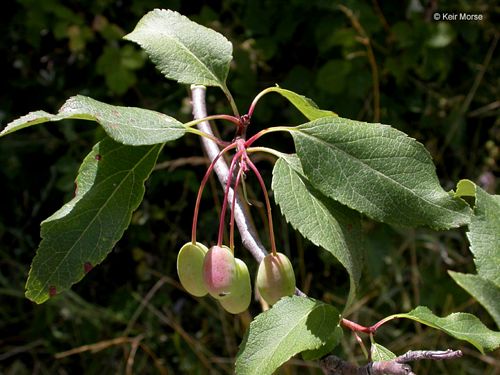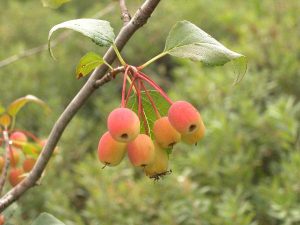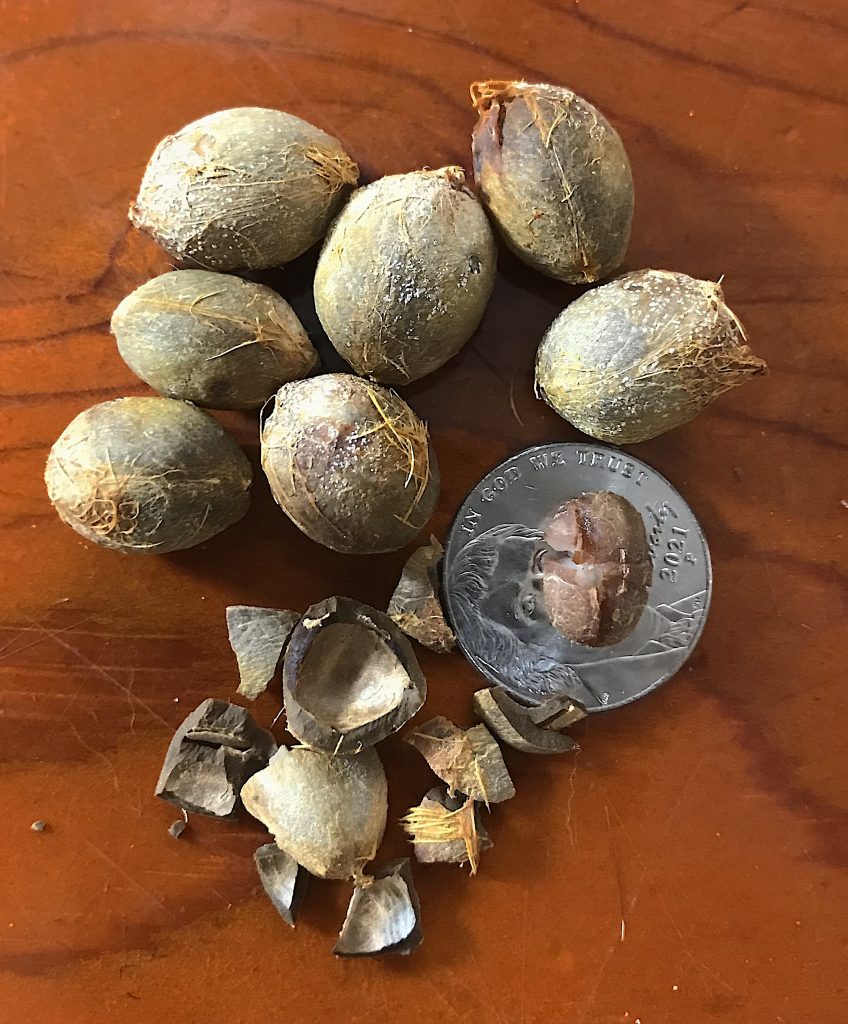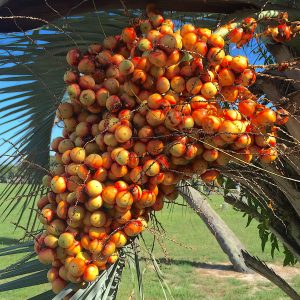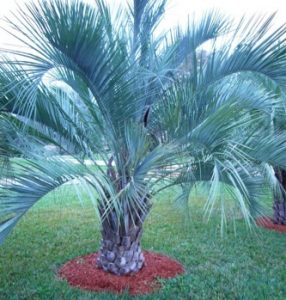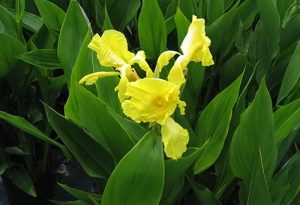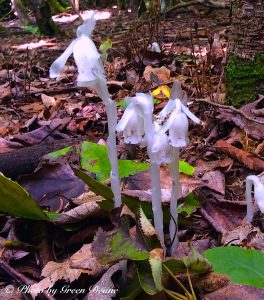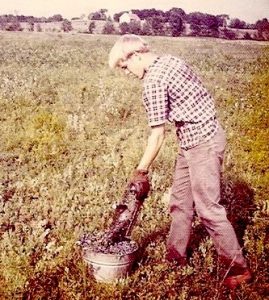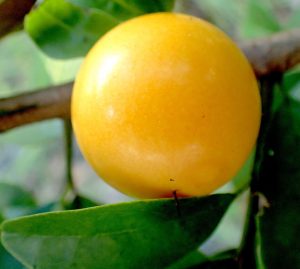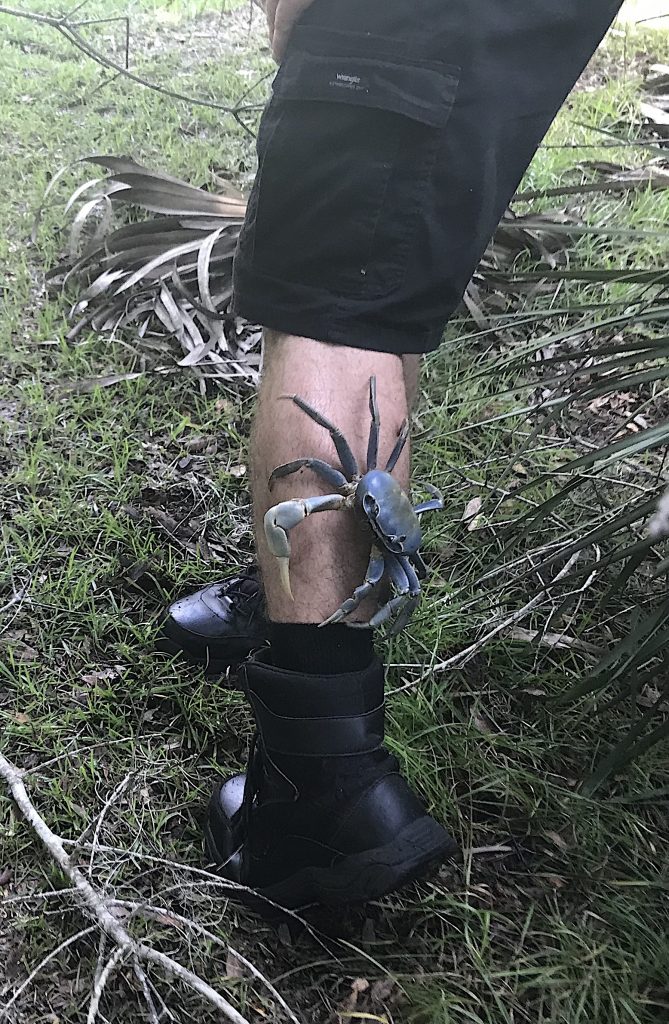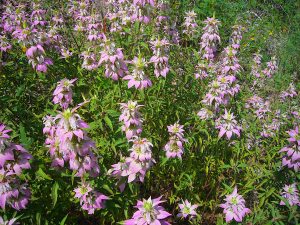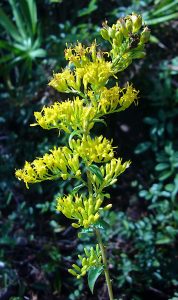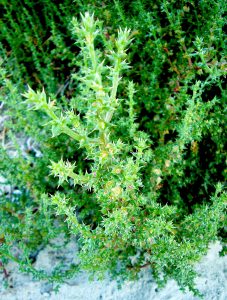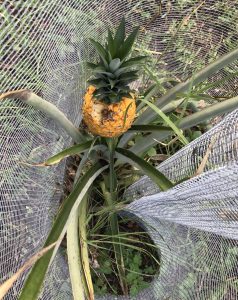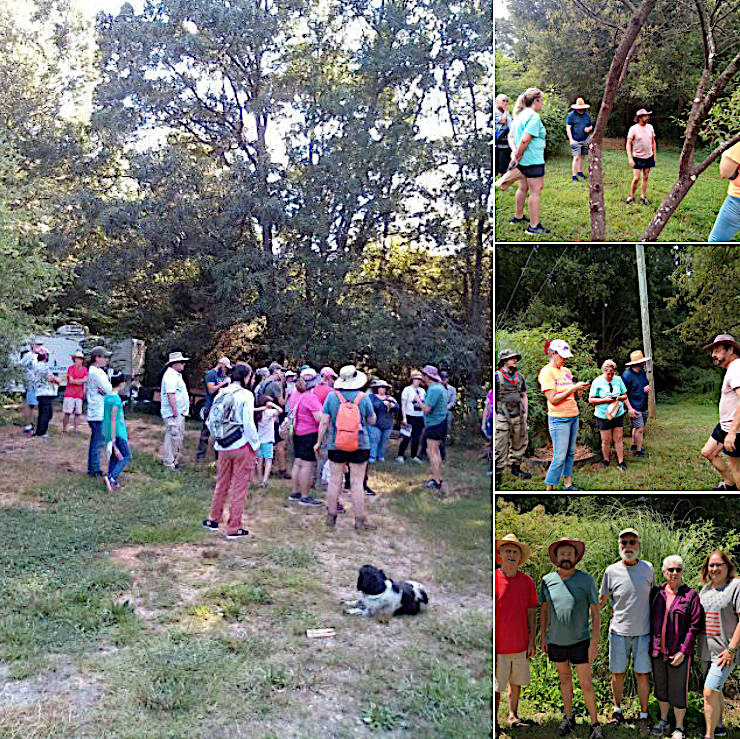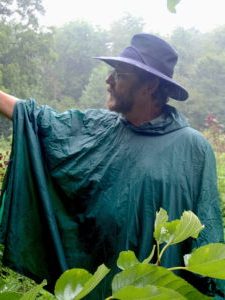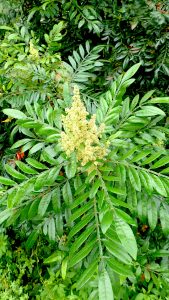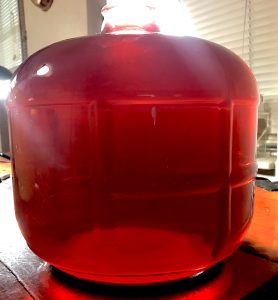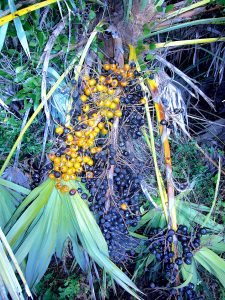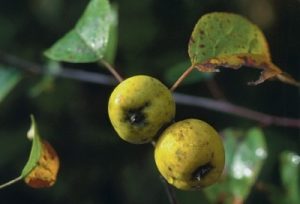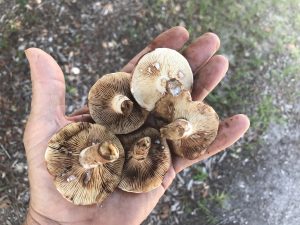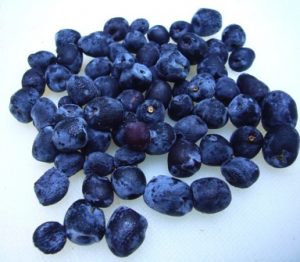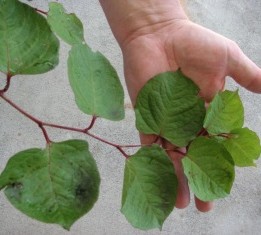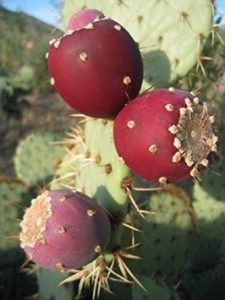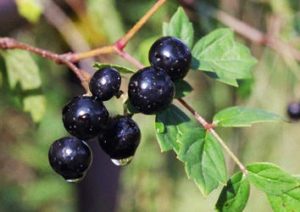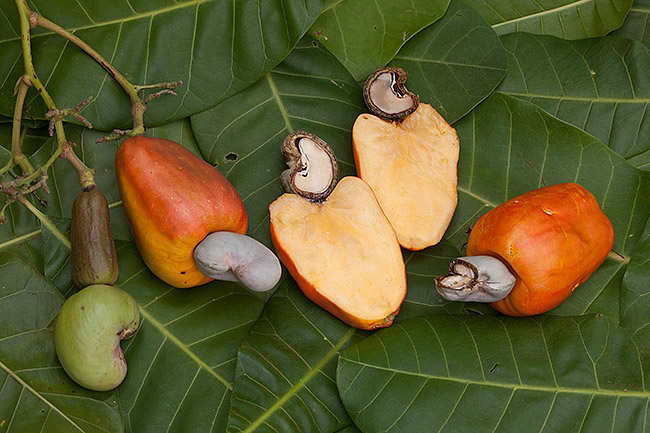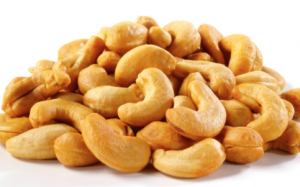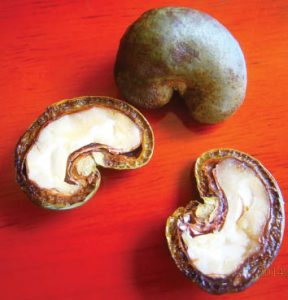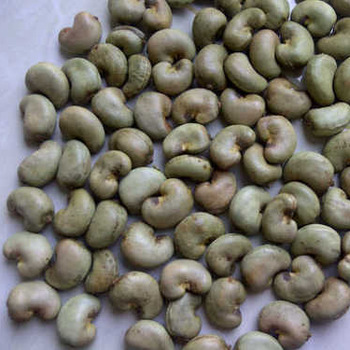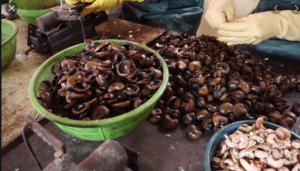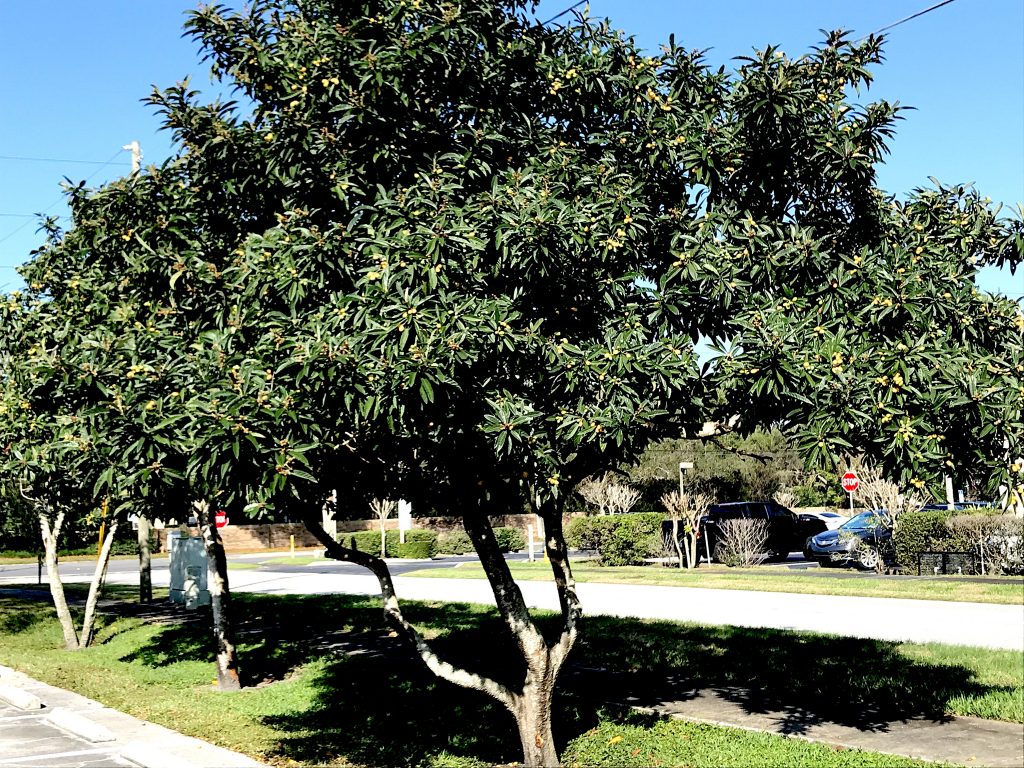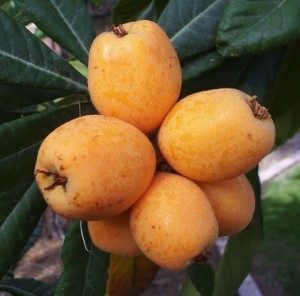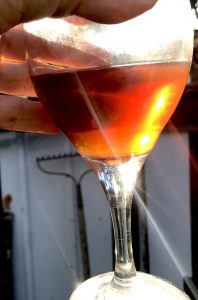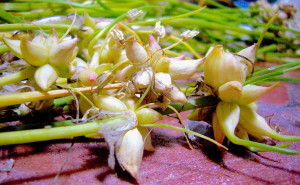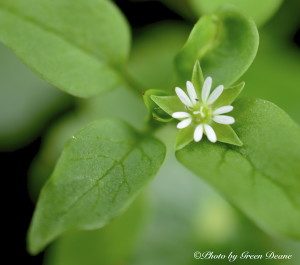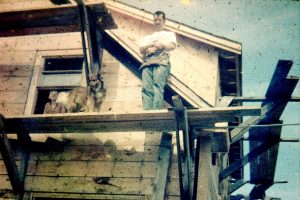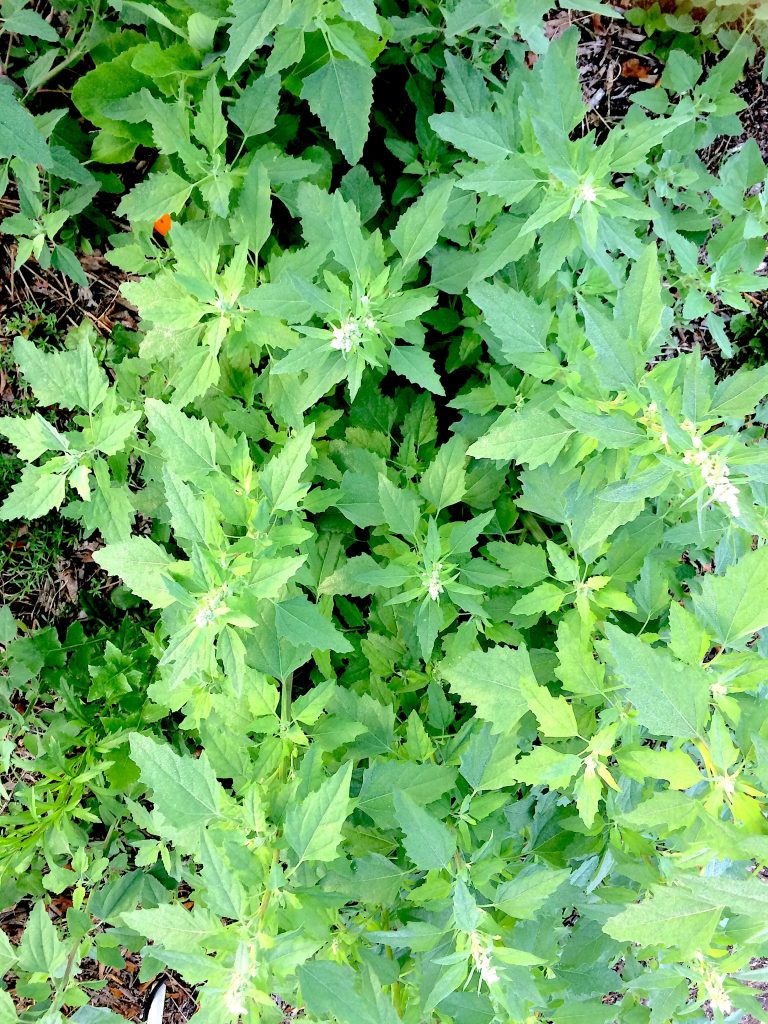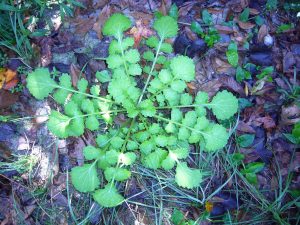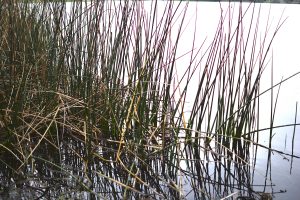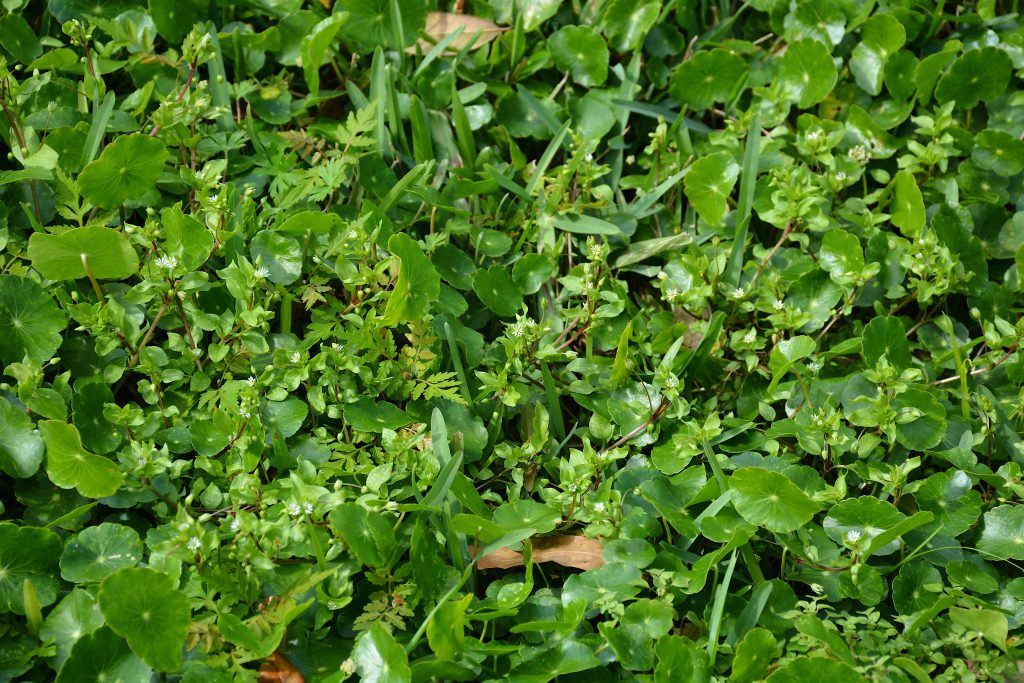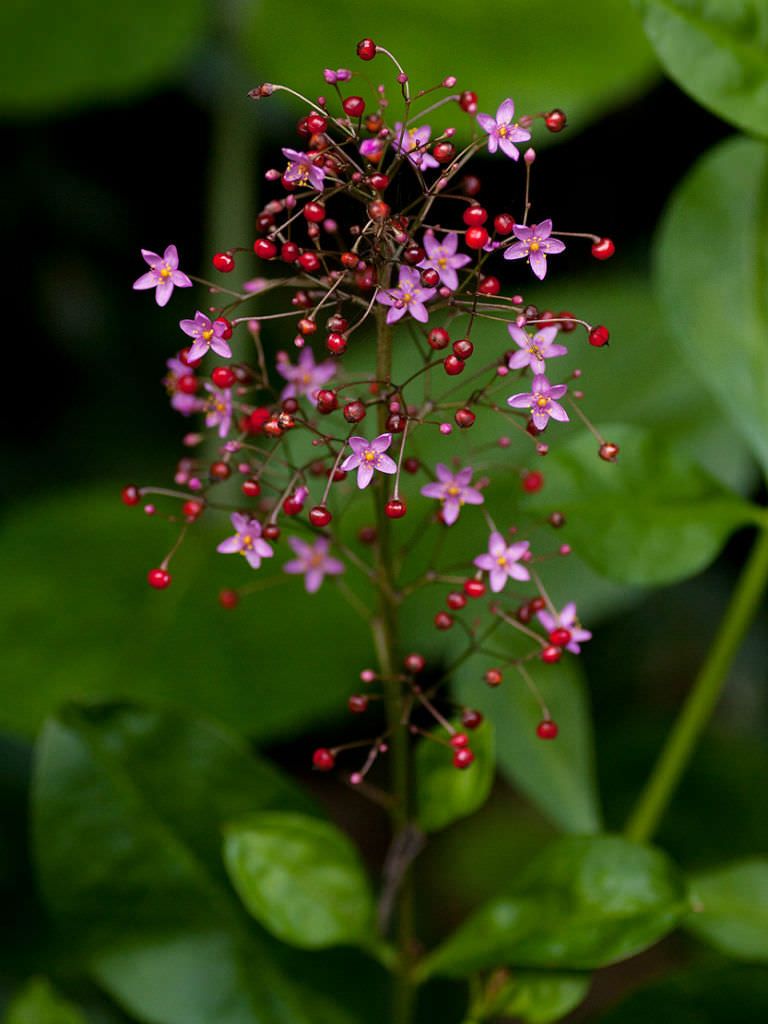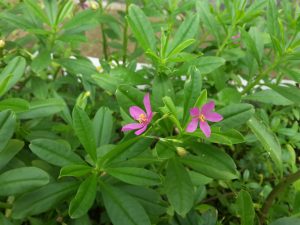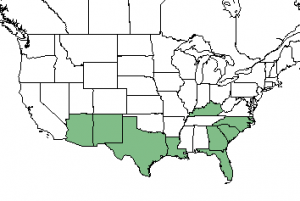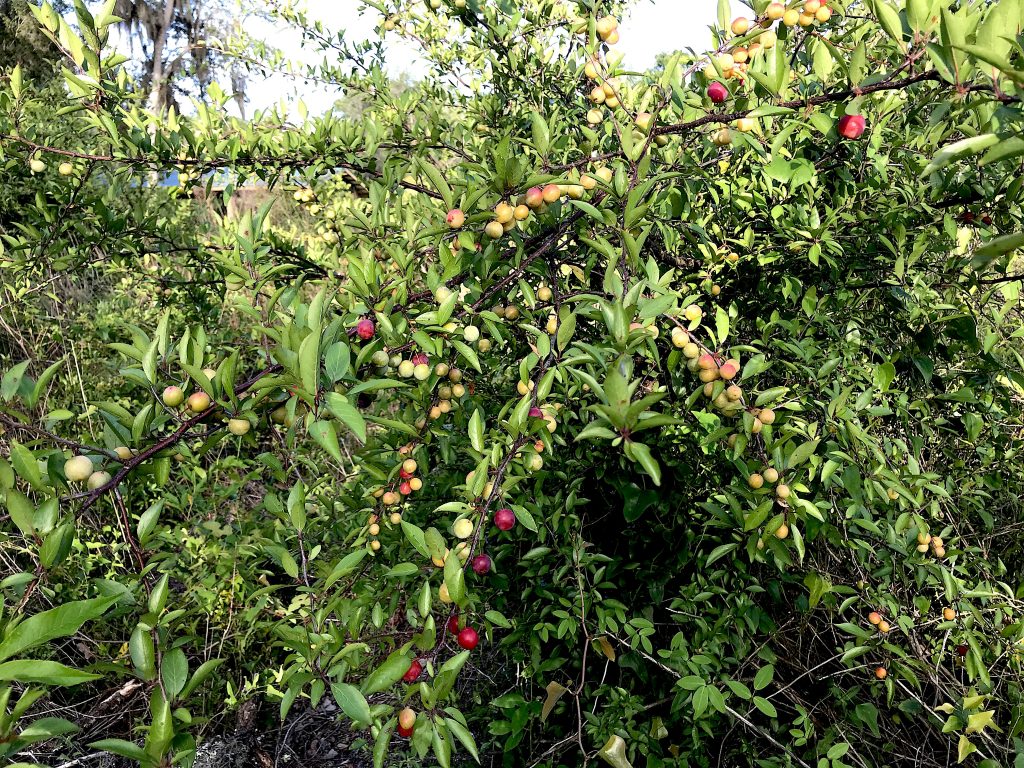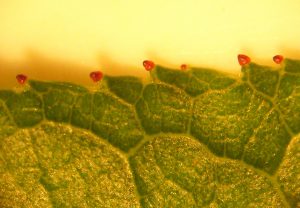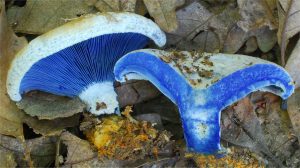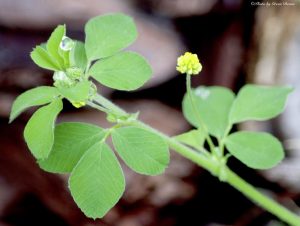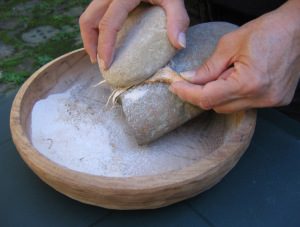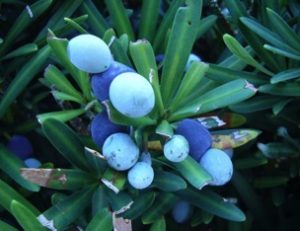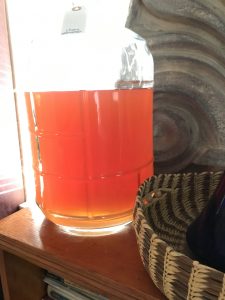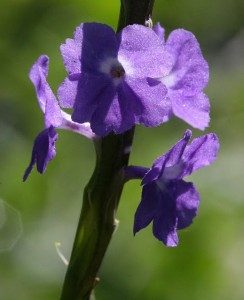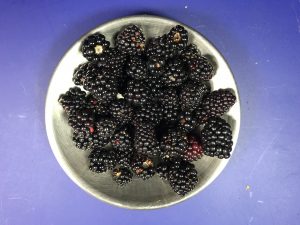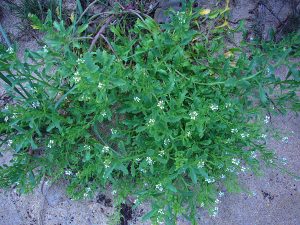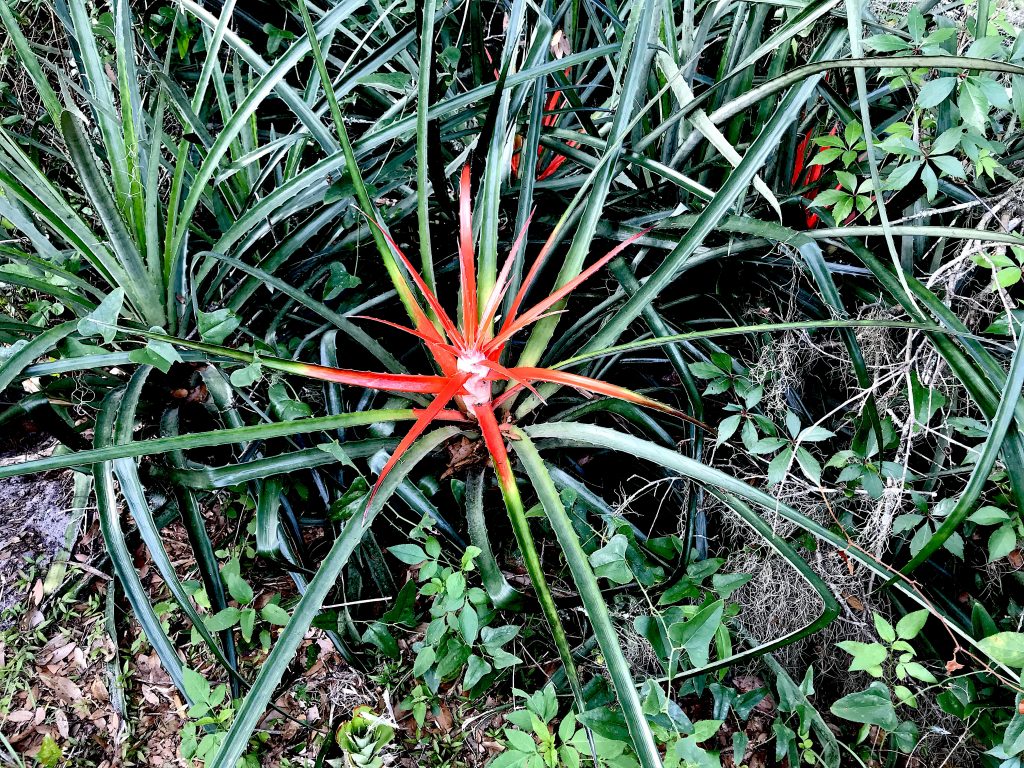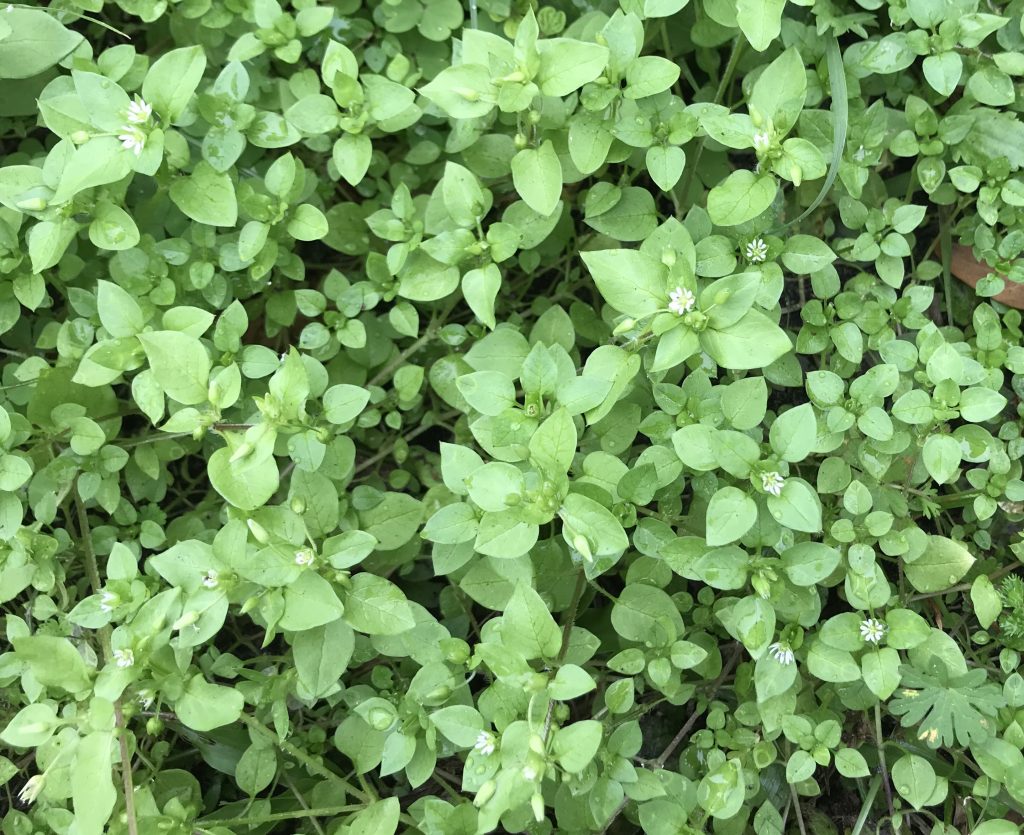
Chickweed is happy now. Bright green foliage in gray lawns. Photo by Green Deane
Our tasty winter green chickweed is in its glory; lush, full, blossoming, happy to be alive. With such healthy plants it was easy to find the identifying characteristics: stretchy inner core, a single line of hair on the main stem that switches 90 degrees at the nodes, a five-petal blossom that looks like 10 petals, and uncooked chickweed tastes like raw corn. We saw a lot of it in Ocala Sunday.
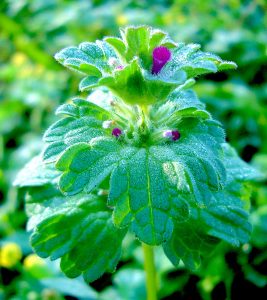
Henbit, one of the few “sweet” springtime greens. Photo by Green Deane
When lawns aren’t mowed food grows. The weather is perfect and winter plants a plenty. We saw the large acorns of the Chestnut Oak, by far the largest locally. In abundance during our foraging classes were Sheep’s Sorrel, Oxalis, Latex Stranger Vine, Pellitory, Black Medic, Wild Geraniums, Horsemint and Henbit. The latter was a favored spring time green with Native Americans because it’s mild rather than peppery. While in the mint family it is not minty. It’s edible raw or cooked. An edible relative, “Dead Nettle” looks similar but is more purple. Henbit is called “Henbit” because chickens like it. It’s usually found in sunny, non-dry places. To read more about Henbit go here. Surprisingly what we didn’t see in Stinging Nettle.
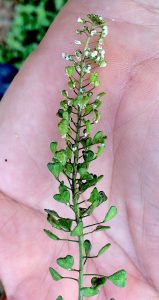
Shepherd’s Purse Photo by Green Deane
During the class the seasonal mustards were also on display. Poor Man’s Pepper Grass was everywhere. But we also saw mild Western Tansy Mustard. Hairy Bittercress was found nearby as was a plain old mustard. Also well-represented this past week was Shepherd’s Purse, Capsella bursa-pastoris, a much milder relative of Poor Man’s Pepper Grass. They have similar blossoms but differently shaped leaves and seed pods. The Shepherd’s pods look more like hearts than “purses.” One interesting aspect about Shepherd’s Purse — photo left — is that I personally have never seen it growing south of the Ocala area. It’s found in 18 northern counties of Florida, one west central Florida county, Hillsborough, one southern Florida county, Dade, and throughout North America. It’s just kind of sparse in the lower half of the state.
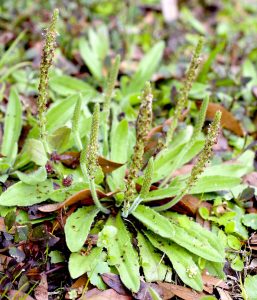
Our native Plantgo is in season.
There are Plantains that look like tough bananas and there are Plantains that are low and leafy plants. They are not related. Just two different groups with the same common name. Low-growing Plantains can be native or non-native. The one pictured right is native, the Dwarf Plantain. As a genus the plants are well-known. The leaves are edible raw when young. As they age they become more bitter and stringy. Cooking makes them palatable up to a point. Then they move into the astringent medical realm. As such they are used on bites, stings and to help puncture wounds heal. The seeds are edible once produced and are the source of the commercial dietary fiber, psyllium. When finely ground the seeds are sold under the brand name Metamucil. There are numerous species of Plantagos (Plantains) with at least five common locally, P. virginiana, P. major, P. lanceolata and P. rugelii the latter which strongly resembles P. major. They are all used the same way. (P. rugelii is pink at the base of the stem.)
One problem beginning foragers have is confusing young Oakleaf Fleabane leaves for Dwarf Plantain leaves (they are both rosette-ish, low-growing green leaves, hairy with fibrous threads in the stem.) But the Dwarf Plantain is essentially a long skinny hairy leaf with a few teeth. The Oakleaf Fleabane is much fatter, has lobes, and does resemble oak leaves found on more northern species. You can read about the Plantains here and I have a video here.
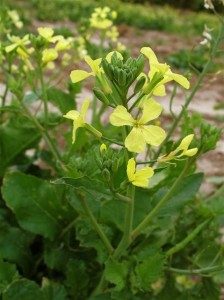
Wild Radish are reaching peak season.
Mustards like chilly weather, or at least locally they do. You can see Wild Mustards and Wild Radish not only along roadsides now but in various fields from farm land to ignored citrus groves. The two species are used interchangeably and look similar. However Wild Radishes tend to be serpentine rather than straight and tall like Wild Mustard. They also have lumpy seed pods, or, more lumpy than mustard seed pods. Usually you will find a stand of one or the other. I don’t recall finding both in the same patch. Blossom colors can range from yellow to white with streaks of purple. But the leaves always have the biggest lobe on the end farthest from the plant. Look for them in sunny areas with fertile soil. Not native they came from Eurasia in the 1700s. And note the seeds can remain viable in the soil for up to 60 years. To read more Wild Radish go here, and for Wild Mustard, here.
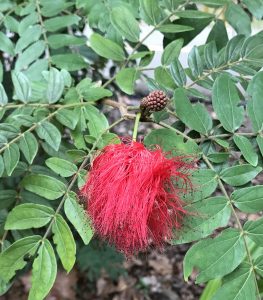
Calliandra Haematocephala is toxic.
A toxic powder puff shrub we see this time of year is a native of Malaysia. It’s a small tree that was in the pea family but has been moved to the Mimosa group. It is not edible in any way. It’s just pretty, which has its own value. The name is slightly interesting in that it is all Living Greek mangled by new Dead Latin. Calliandra is a combination of Kallos (beautiful) and Andros (man) but is to mean — when poetically translated — “pretty stamen” (the male part of the flower which creates the powder puff.) Haematocephala means “blood head” or in this case “red head.” Thus pretty stamen red head. You could even stretch it to “pretty redheaded man.” The common name is Red Powder Puff.

Classes are held rain or shine.
Foraging Classes: Two classes this weekend, Saturday in West Palm Beach and Sunday in Winter Park.
Saturday, January 9th, Dreher Park, 1200 Southern Blvd., West Palm Beach, 33405. 9 a.m. to noon. Meet just north of the science center.
Sunday, January 10th, Mead Gardens, 1500 S. Denning Dr., Winter Park, FL 32789. 9 a.m. to noon. The entrance is on the west side off Denning not the east side off Pennsylvania. Some GPS maps are wrong. Meet near the bathrooms.
Saturday, January 16th, Eagle Park Lake, 1800 Keene Road, Largo, FL 33771. 9 a.m. to noon. Meet at the dog park pavilion.
Sunday, January 17th, Spruce Creek, 6250 Ridgewood Ave. Port Orange, 32127. 9 a.m. to noon. Meet that the pavilion (first right after house.)
Saturday, January 23th, Blanchard Park, 10501 Jay Blanchard Trail, Orlando, FL 32817. 9 a.m. to noon, meet at the pavilion by the tennis courts.
Sunday, January 24th, Red Bug Slough Preserve, 5200 Beneva Road, Sarasota, FL, 34233. 9 a.m. to noon.
Saturday January 30th, Wickham Park: 2500 Parkway Drive, Melbourne, FL, 9 a.m. to noon. Meet at the dog park.
Sunday January 31st, Bayshore Live Oak Park, Bayshore Drive. Port Charlotte. 9 a.m. to noon, meet in the parking lot at Ganyard and Bayshore.
Saturday February 6th, Boulware Springs Park, 3420 SE 15th St., Gainesville, FL 32641. 9 a.m. to noon, meet at the pavilion by the pump house.
Sunday, February 7th, Mead Gardens, 1500 S. Denning Dr., Winter Park, FL 32789. 9 a.m. to noon. The entrance is on the west side off Denning not the east side off Pennsylvania. Some GPS maps are wrong. Meet near the bathrooms.
For more information, to pre-pay, or sign up go here.
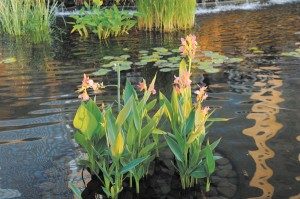
Canna can grow in a garden or a pond.
♣ Botany Builder #12. Do you remember the confusion in school over the words immigrant and emigrant? An emigrant is someone leaving a country, and an immigrant is someone entering a country. An emergent plant is one coming out of the water, such as Canna. It likes to grow in about a half a foot of water. It doesn’t like dry land and it doesn’t like deep water. It is emergent. Cattails are emergent, however some species of cattail — there aren’t that many — like to be close to shore and others like deeper water. What it really comes down to, can you get cattails from shore or do you need a canoe?

Green Deane videos are now available on a USB.
150-video USB or 135 video DVD set would be a good winter present and either is now $99. My nine-DVD set of 135 videos has been selling for seven years and are still available. They are the same videos I have on You Tube. Some people like to have a separate copy. A second option is a16-gig USB that has those 135 videos plus 15 more. While the videos can be run from the DVDs the videos on the USB have to be copied to your computer to play. They are MP4 files. The150-video USB is $99 and the 135-video DVD set is now $99. The DVDs will be sold until they run out then will be exclusively replaced by the USB. This is a change I’ve been trying to make for several years. So if you have been wanting the 135-video DVD set order it now as the price is reduced and the supply limited. Or you can order the USB. My headache is getting my WordPress Order page changed to reflect these changes. We’ve been working on it for several months. However, if you want to order now either the USB or the DVD set make a $99 “donation” using the link at the bottom of this page or here. That order form provides me with your address, the amount — $99 — tells me it is not a donation and in the note say if you want the DVD set or the USB.

Green Deane Forum
Want to identify a plant? Perhaps you’re looking for a foraging reference? You might have a UFO, an Unidentified Flowering Object, you want identified. On the Green Deane Forum we — including Green Deane and others from around the world — chat about foraging all year. And it’s not just about warm-weather plants or just North American flora. Many nations share common weeds so there’s a lot to talk. There’s also more than weeds. The reference section has information for foraging around the world. There are also articles on food preservation, and forgotten skills from making bows to fermenting food.
This is weekly newsletter #439. If you want to subscribe to this free newsletter you can find the sign-up form in the menu at the top of the page.
To donate to the Green Deane Newsletter click here.
